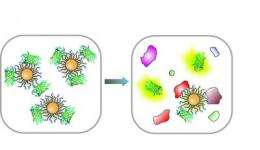Chemists develop nose-like sensor array to 'smell' cancer diagnoses

In the fight against cancer, knowing the enemy's exact identity is crucial for diagnosis and treatment, especially in metastatic cancers, those that spread between organs and tissues. Now chemists led by Vincent Rotello at the University of Massachusetts Amherst have developed a rapid, sensitive way to detect microscopic levels of many different metastatic cell types in living tissue. Findings appear in the current issue of the journal ACS Nano.
In a pre-clinical non-small-cell lung cancer metastasis model in mice developed by Frank Jirik and colleagues at the University of Calgary, Rotello's team at UMass Amherst use a sensor array system of gold nanoparticles and proteins to "smell" different cancer types in much the same way our noses identify and remember different odors. The new work builds on Rotello and colleagues' earlier development of a "chemical nose" array of nanoparticles and polymers able to differentiate between normal cells and cancerous ones.
Rotello explains, "With this tool, we can now actually detect and identify metastasized tumor cells in living animal tissue rapidly and effectively using the 'nose' strategy. We were the first group to use this approach in cells, which is relatively straightforward. Now we've done it in tissues and organs, which are very much more complex. With this advance, we're much closer to the promise of a general diagnostic test."
Until now the standard method for precisely identifying cancer cells used a biological receptor approach, a protein binding to a cancer cell wall. Its major drawback is that one must know the appropriate receptor beforehand. Rotello and colleagues' breakthrough is to use an array of gold nanoparticle sensors plus green fluorescent protein (GFP) that activates in response to patterns in the proteins found in cancer cells within minutes, assigning a unique signature to each cancer.
The chemist says, "Smell 'A' generates a pattern in the nose, a unique set of activated receptors, and these are different for every smell we encounter. Smell 'B' has a different pattern. Your brain will instantly recognize each, even if the only time you ever smelled it was 40 years ago. In the same way, we can tune or teach our nanoparticle array to recognize many healthy tissues, so it can immediately recognize something that's even a little bit 'off,' that is, very subtly different from normal. It's like a 'check engine' light, and assigns a different pattern to each 'wrong' tissue. The sensitivity is exquisite, and very powerful."
For this work, the researchers took healthy tissue and mouse tumor samples and trained the nanoparticle-GFP sensor array to recognize them and the GFP to fluoresce in the presence of metastatic tissue. Metastases are differentiated from healthy tissue in a matter of minutes, providing a rapid and very general means of detecting and identifying cancer and potentially other diseases using minimally invasive microbiopsies.
"It's sensitive to really subtle differences," says Rotello. "Even though two cheeses may look the same, our noses can tell a nicely ripe one from a cheese that's a few days past tasting good. In the same way, once we train the sensor array we can identify whether a tissue sample is healthy or not and what kind of cancer it is with very high accuracy. The sensitivity is impressive from a sample of only about 2,000 cells, a microbiopsy that's less invasive for patients."
In addition to the high sensitivity, the authors point out, their sensor is able to differentiate between low (parental) and high (bone, adrenal, and ovary) metastases, as well as between site-specific cells such as breast, liver, lung and prostate cancers.
"Overall, this array-based sensing strategy presents the prospect of unbiased phenotype screening of tissue states arising from genetic variations and differentiation state." Their next step will be to test the new sensor array method in human tissue samples, the researchers say.
Journal information: ACS Nano
Provided by University of Massachusetts Amherst

















